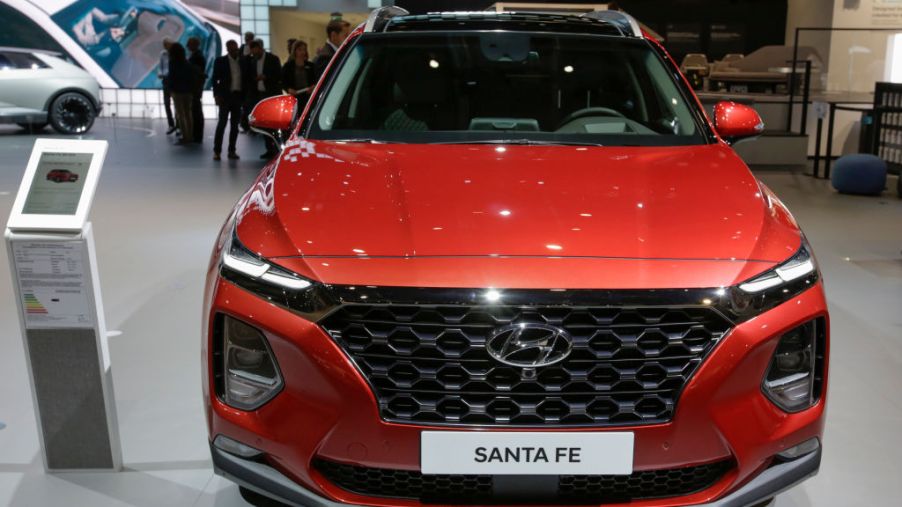
What’s the Difference Between the Hyundai Tucson and Hyundai Santa Fe?
Hyundai alone offers seven different SUVs for 2020. With so many SUVs for buyers to choose from these days, how can people tell them apart? The Hyundai Tucson and Hyundai Santa Fe are two that people looking for a two-row SUV may consider. Here’s a look at how they compare.
The 2020 Hyundai Santa Fe has better ratings
While they are different sizes, the Hyundai Tucson and Hyundai Santa Fe measure up differently against their competitors. U.S. News & World Report ranks the 2020 Hyundai Tucson as an average compact SUV. U.S. News & World Report gives a number of ratings and rankings.
The Tucson is #7 in compact SUVs, #27 in crossover SUVs, and #17 in SUVs with two rows. It has an overall score of 7.8 on the U.S. News & World Report scorecard. J.D. Power gave the 2020 Hyundai Tucson a strong predicted reliability rating of four out of five.
U.S. News & World Report ranks the 2020 Santa Fe as the #1 midsize SUV. It also won the organization’s 2020 Best 2-Row SUV for the Money and was a finalist for the 2020 Best 2-Row SUV for Families. It’s ranked #3 in crossover SUVs and #3 in SUVs with 2 rows, with an overall score of 8.5 on the U.S. News & World Report scorecard. It also has an excellent predicted reliability rating from J.D. Power, with a 4.5 out of five.
The Santa Fe offers more size and space
The Tucson and Santa Fe both seat five people. Both offer less cargo room than their competitors, but the Santa Fe has more space than the Tucson. The Tucson has 31 cubic feet of cargo space, which increases to 61.9 cubic feet with the rear seats folded down.
It is easy to load items into the cargo area because of the wide opening. A hands-free power liftgate is an available feature. The Santa Fe offers 35.9 cubic feet of cargo space and 71.3 cubic feet when the rear seats are folded down.
The Santa Fe is a foot longer than the Tucson. The Tucson is 14.7 feet in length. Its curb weight is between 3,309 and 3,732 pounds. The Santa Fe is 15.7 feet long, with a curb weight of between 3,591 and 4,085 pounds.
Both SUVs have an underwhelming powertrain
The Tucson and Santa Fe both have what U.S. News & World Report calls a “smooth ride.” However, U.S. News & World Report says the Tucson has an “underpowered engine lineup.”
The standard Tucson has a 2.0-liter four-cylinder engine, generating 161 hp. A 2.4-liter four-cylinder engine is available, generating 181 hp. Both are paired with a six-speed automatic transmission. U.S. News & World Report says the engines are fine for driving around town but “feel lethargic on the highway.”
U.S. News & World Report calls the Santa Fe’s base engine “underwhelming.” That four-cylinder engine has 185 hp. The stronger engine is a 235-hp turbocharged four-cylinder. The engines are paired with an eight-speed automatic transmission. Both SUVs come with front-wheel drive, but all-wheel drive can be added.
Fuel efficiency
The Tucson and Santa Fe have pretty similar fuel efficiency to each other, but the Santa Fe measures up better against its competitors than the Tucson does. The Tucson isn’t as fuel-efficient as some competitors. It gets 21 to 23 MPG in the city and 25 to 28 MPG on the highway, for a combined 23 or 25 MPG. The ranges depend on the engine choice and whether the Tucson is front-wheel drive or all-wheel drive.
The Santa Fe measures up well in fuel economy against its competitors. The base engine gets 22 MPG in the city and 29 MPG on the highway, for 25 MPG combined. The turbo-four engine gets 20 MPG city and 27 MPG highway, for a combined 23 MPG. All-wheel drive reduces those ratings by about one MPG.
The best and worst of the two models
U.S. News & World Report points out that both the Tucson and the Santa Fe provide a nice ride, comfortable seats, and similar standard features. The most significant differences between the two SUVs are in the size and cost.
The Santa Fe is larger but also costs more than the Tucson. The Tucson has six trim levels to pick from (SE, Value, SEL, Sport, Limited, and Ultimate), while the Santa Fe has three (SE, SEL, and Limited). The 2020 Hyundai Tucson has a starting price of $23,550, and the 2020 Hyundai Santa Fe starts at $26,125.


